Picture yourself in a thick, green rainforest, full of all sorts of animals. Birds are a big group of victims here, with everyone from parrots to raptors under threat. They’re hunted by various predators seeking their next meal.
From the Harpy Eagle to the quick Jaguar, many creatures want to catch these birds. It’s important to know how this hunt-and-be-hunted game works. This helps us see why these ecosystems are so special.
Key Takeaways
- The tropical rainforest is home to a diverse array of bird predators, including raptors, snakes, cats, primates, and even bats.
- Birds have developed various survival tactics, such as flocking behavior and careful nest selection, to avoid these skilled hunters.
- Exploring the predator-prey relationships in the rainforest ecosystem provides insight into the intricate web of life in these biodiverse environments.
- Rainforest birds face a constant threat from a range of predators, highlighting the need for conservation efforts to protect these vulnerable species.
- Maintaining the delicate balance of the rainforest ecosystem is crucial for the survival of both birds and their predators.
Introduction to Rainforest Ecology
Tropical rainforests are incredibly complex and diverse. They support a vast amount of plant and animal life. These environments are full of a delicate balance where every species, large or small, has a key role. This balance helps maintain the health and function of these ecosystems.
The Intricate Web of Life in Tropical Rainforests
The tropical rainforest is like a complex woven tapestry. It shows how different species depend on each other. This web of life highlights the intense biodiversity in these areas. For instance, rainforests can have up to 100 different tree species in just one hectare. They also house a wide range of insects, birds, and other animals that all live and depend on one another.
Importance of Each Species in the Ecosystem
Every species, no matter its size, has an important part in the rainforest. Leaf-cutter ants recycle nutrients while hummingbirds pollinate plants. The loss of any species could disrupt the whole ecosystem. This loss might harm other species that rely on it for survival.
The abundance of life in tropical rainforests is both beautiful and crucial. They are vital for the planet, regulating climate and supporting countless species, including humans. By understanding how all these species connect, we can help protect these environments for the future.
“Rainforests are Earth’s oldest living ecosystems, with some surviving for at least 70 million years.” – Rainforest Ecology Fact
| Rainforest Ecology Statistic | Value |
|---|---|
| Rainforests cover just six percent of Earth’s surface | 6% |
| Rainforests are home to more than half of the world’s plant and animal species | Over 50% |
| A 10-square-kilometer patch of rainforest can contain 400 species of birds | 400 species |
| The Brazil nut tree in the Amazon rainforest can live up to 1,000 years | 1,000 years |
| The canopy layer of the rainforest is roughly six meters thick | 6 meters |
| Thousands of insect species can be found in the canopy layer | Thousands |
Insects: The Unseen Majority
Tropical rainforests are full of life, especially insects. They are vital, working as decomposers, pollinators, and food for bigger animals. Without insects, the ecosystem would struggle to exist.
Diverse Roles of Insects in the Rainforest
The Amazon Rainforest has about 2.5 million insect species. They help nature by breaking down dead things and pollinating plants. This process keeps the forest green and healthy.
Insects are key in the rainforest food chain. Whether they are hunting or avoiding being hunted, they provide food for many animals. This includes birds, reptiles, and even amphibians. Without insects, many animals would not survive.
Larger-than-Life Insects in the Tropics
In the rainforest, some insects are huge, bigger than what we see in other places. The Amazon has dragonflies with big wings and walking sticks that are as long as your ruler. These big insects show how amazing rainforest life is.
Insects in the rainforest help in many ways. They break down waste, pollinate, and feed other animals. This shows how important insects are for the rainforest to be a thriving place.
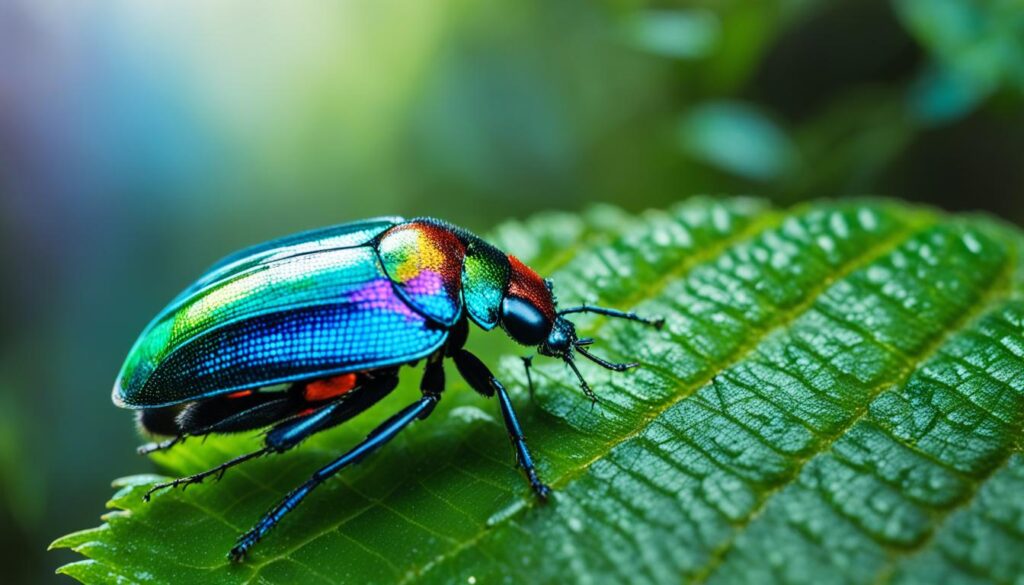
“Insects are the most numerous animals in rainforests, with the Amazon Rainforest alone being home to approximately 2.5 million species of these tiny creatures.”
Amphibians: Colorful Predators
Deep in the tropical rainforests, an amazing group of animals lives. This group is the amphibians, which include frogs and salamanders. They are key parts of the rich life in these green areas. The poison dart frogs stand out with their bright colors and dangerous toxins, grabbing the attention of those who love nature.
Poison Dart Frogs and Their Deadly Defenses
Poison dart frogs are known for their vivid colors and patterns. They are tiny but very strong. They make a toxin that protects them from their enemies. Some of these toxins can even hurt and kill big animals, like people.
Some groups have used the poison from these frogs to make their arrows deadly. These frogs live in the wet parts of the forest. They eat small bugs. The bright colors they have are a warning to others, saying “stay away.”
But, poison dart frogs are in trouble today. People cutting down forests, destroying their homes, polluting, and taking them for pets are some problems. So, many of these frogs are at risk of disappearing because of what people do.
“Poison dart frogs can produce toxins that are up to 200 times more potent than morphine, making them one of the most deadly creatures on the planet.”
We need to help keep these amazing animals safe. Protecting their homes and using the forest wisely can save them. This way, the poison dart frogs and other forest animals can keep living for a long, long time.
Reptiles: Masters of Camouflage
In the rainforest, reptiles are masters of hiding. For example, the big anaconda and the shy coral snake blend in well. They use special tactics to look like their green, tropical home.
Many snakes are experts at hiding. Boas and pythons sneak up on their prey. They rely on their sharp eyes and their skin’s colors. This helps them catch food without being seen.
The venomous coral snake is known for its bright colors. It uses red, black, and yellow bands as a warning. This tells others it’s dangerous.
Lizards also know how to disappear. In Madagascar, the leaf-tailed gecko can sound like a human screaming to ward off danger. And the leaf-litter toad in South America looks just like the leaves on the ground. This hides it from enemies and prey.
This skill isn’t just for snakes and lizards. Wrap-around spiders in Australia look like tree bark. They do this to hide from other animals. In Southeast Asia, pygmy seahorses live on colorful reefs. They blend in by looking like part of the coral.
| Reptile Species | Camouflage Technique | Habitat |
|---|---|---|
| Giant leaf-tailed gecko | Mimics human-like scream | Madagascar |
| Leaf-litter toad | Blends with forest floor | South America |
| Wrap-around spider | Flattens against tree trunks | Australia |
| Pygmy seahorse | Calcified tubercles blend with coral | Southeast Asia |
Reptiles in the rainforest show how incredible nature can be. They adapt to their habitat in amazing ways. Whether they mimic sounds or hide in plain sight, these creatures are true survivors.
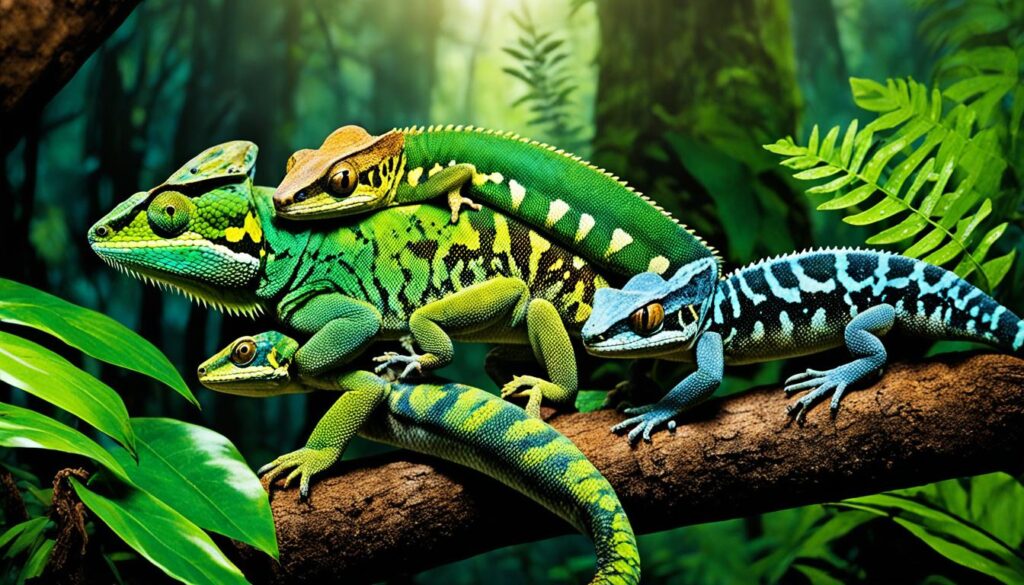
Fish: Rulers of the Waterways
The tropical rainforest has many waterways where countless fish species live. These fish help keep the forest healthy by eating plants and leaving behind nutrients. The piranha, known for its sharp teeth, lives in the Amazon River. It competes for food with other species in the area.
The Notorious Piranha and Its Survival Tactics
Piranhas are small but tough fish found in South America’s freshwater areas. They have sharp, triangular teeth. Piranhas are skilled hunters, eating not just small fish but also bigger animals that enter the water.
Swimming together in large groups, piranhas use teamwork to catch prey. This way, they can eat larger creatures. Their strong jaws and sharp teeth help them eat quickly, making them top predators in their habitat.
Though piranhas are often feared, they rarely attack people. This happens mainly if they are scared or if there’s blood in the water. Despite this, their reputation in stories and movies is that of dangerous killers.
“The piranha is not the ferocious, indiscriminate killer of popular legend. It is an opportunistic feeder that will take advantage of injured or dying animals, but is generally not a threat to healthy humans.”
The piranha and other fish are key to the rainforest’s water health. They are critical in maintaining the ecosystem’s balance. Their presence is vital for the overall well-being of the underwater world in the rainforest.
Birds: The Vibrant Aerial Hunters
Rainforests overflow with a diverse range of rainforest birds. They all have major roles in the complex bird ecology of these thriving areas. From the noisy parrots to the beautiful toucans, the rainforest is full of these avian predators.
The birds high up in the rainforest trees aren’t just watching. They are crucial in the tropical bird species food chain. Acting as both hunters and the hunted, rainforest birds help keep the place in balance.
Role of Birds in the Rainforest Food Chain
Rainforest birds do more than just look pretty. Many types help spread seeds, keeping the forests diverse. They also feed larger animals like raptors and snakes, a key part of the bird ecology.
- Rainforests cover only between 6 and 7% of the world’s land surface but are home to more than half of all the world’s animal and plant species.
- Biologists estimate that there are millions of species living in rainforests still to be discovered.
- The Amazon Kingfisher, a resident of the South American rainforests, has a conservation status of Least Concern.
- The Amazonian Giant Centipede, a fearsome predator in the Amazon Basin, can reach lengths of up to 30 cm.
It’s important to grasp the role of rainforest birds in the tropical bird species food chain. This knowledge is key to balancing these special places. By understanding how important these flying hunters are, we can value the rainforest’s whole system and protect it better.
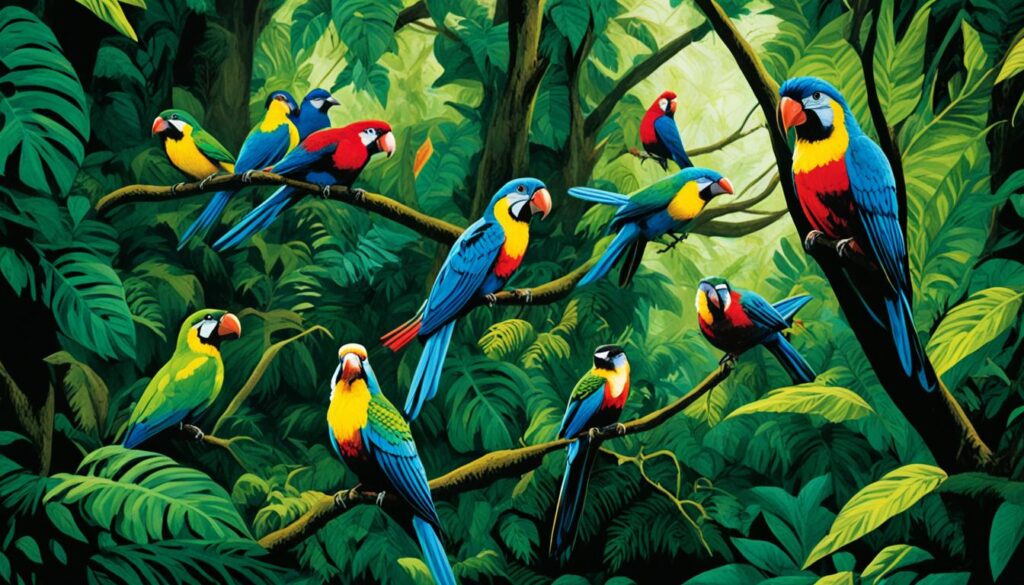
Mammals: From Tiny to Mighty
The tropical rainforest is a hub of mammal diversity. It shelters creatures from tiny mice to the great jaguar. These animals are key in keeping the rainforest’s life cycle balanced.
Humans and Their Impact on the Rainforest
Humans are the most influential mammals in the rainforest. We have a special duty to guard these vulnerable places. Our actions, like cutting down trees, pushing away species, and using too many resources, harm the rainforest’s life.
Smaller mammals are food for big predators. Meanwhile, large animals, like sloths and armadillos, play a big part in keeping the ecosystem healthy. The Amazon rainforest alone hosts over 427 mammal species, with bats and rodents being the most common. Those living beings are facing threats because of what humans do.
| Rainforest Mammal Species | Characteristics |
|---|---|
| Harpy Eagle | Can reach wingspans of 6.5 feet and weigh up to 24 pounds. Females are twice as large as males. |
| Blue Morpho Butterfly | They live for 115 days and are found in the tropical rainforests of Latin America. |
| Pink River Dolphin | Inhabit freshwater and have a rosy coloring. They face threats from pollution. |
| Giant River Otter | They can be six feet long and weigh as much as 70 pounds. |
| Capybara | The biggest rodents in the world. They can stay underwater for five minutes. |
Big mammals, like the jaguar and tapir, are top predators. They are essential for the rainforest’s health. But, they are also in danger because of us. Hunting and losing their homes are major threats to them.
To safeguard the rainforest and its mammals, we must act. We need to correct our harmful impacts on these environments. This involves backing efforts for sustainable use of forests, protecting lands, and teaching others about rainforest care.
what eats birds in the rainforest
The tropical rainforest is filled with many predators, making it a tough place for birds. Birds are always on the lookout to avoid being the next meal. These predators range from cats to birds of prey.
Raptors like hawks, eagles, and owls are expert hunters. They use sharp eyesight and quick moves to catch birds in mid-air or on the ground. The Rupicola Peruviana (Cock-of-the-rock), found in the Amazon, is often their target.
Snakes are another danger for rainforest birds. They sneak up on their prey using camouflage and strike quickly. The Blue and Gray Tanager is always watching out for snakes.
Big cats like the Jaguar and Ocelot are skilled bird hunters too. They blend in well and surprise birds, sometimes climbing trees to catch them.
Even some primates catch birds now and then. This adds a surprising twist to the already complex food chain of the rainforest.
Birds have many ways to stay safe. They often flock together and carefully choose where to build their nests. They are also always ready to fly away fast.
This balance between hunter and hunted shows the amazing ways birds adapt and survive in the rainforest.
| Predator | Prey |
|---|---|
| Hawks, Eagles, Owls | Rupicola Peruviana (Cock-of-the-rock) |
| Snakes | Blue and Gray Tanager |
| Jaguar, Ocelot | Various rainforest bird species |
| Primates | Various rainforest bird species |

“The rainforest is a complex tapestry of life, where birds must constantly navigate a treacherous web of predators to survive and thrive.”
Raptors: Winged Assassins
The tropical rainforest teems with fearsome avian predators called raptors. This group includes hawks, eagles, and owls. They use sharp talons and keen eyesight to hunt birds like parrots and macaws.
Hawks, Eagles, and Owls as Avian Predators
The Ornate Hawk-Eagle and the Harpy Eagle stand out for hunting large parrot types. They show how dangerous the rainforest can be. Raptors have many hunting methods, including high-soaring flights and hidden ambushes.
Raptor attacks on rainforest birds can happen up to 25% of the time in some areas. Some raptor types catch prey up to 77% of the time. This shows their high success in hunting.
Owls bring their silent flight and great night vision into the rainforest’s hunting scene. For example, the Spectacled Owl and the Crested Owl hunt a variety of birds, like parrots and toucans, and even small monkeys.
Raptors heavily impact bird populations in the rainforest, with up to 30% of some species becoming prey. Conservationists watch raptors and their prey to understand the rainforest’s ecosystem better.
“The rainforest is a battleground, where the hunters and the hunted engage in a timeless dance of survival. Raptors, with their unparalleled aerial prowess, are the stars of this performance, striking fear into the hearts of their feathered prey.”
Snakes: Stealthy Stalkers
Snakes are key players in the hot, wet world of the tropical rainforest. They use a variety of skills to hunt down birds and other animals. Giant anacondas wrap around their prey, while deadly coral snakes deliver quick venomous bites. These snakes are an essential part of the forest’s natural cycle.
Big constrictor snakes like the anaconda are incredibly strong. They can coil around a bird and squeeze it to death. On the other hand, venomous snakes such as the coral snake have a different trick. They bite their prey, injecting venom that quickly overpowers it.
Rainforest snakes are masters of hidden attacks. They blend in with their surroundings, waiting to surprise their bird victims. They strike suddenly, using the jungle’s thick foliage to stay hidden until the perfect moment.
“Snakes are the silent assassins of the rainforest, striking with lightning speed and deadly precision to maintain their place in the delicate balance of this extraordinary ecosystem.”
Studies suggest that snakes are a major threat to birds in the rainforest. They are responsible for a large chunk of bird deaths, as high as 25%. Snakes are even better at catching birds than typical bird predators like raptors and wild cats.
Snakes are found throughout the rainforest because they are well-adapted predators. For example, some species like the coral snake prefer to eat certain types of birds. The interaction between these predators and their bird prey is key to the rainforest’s rich life.
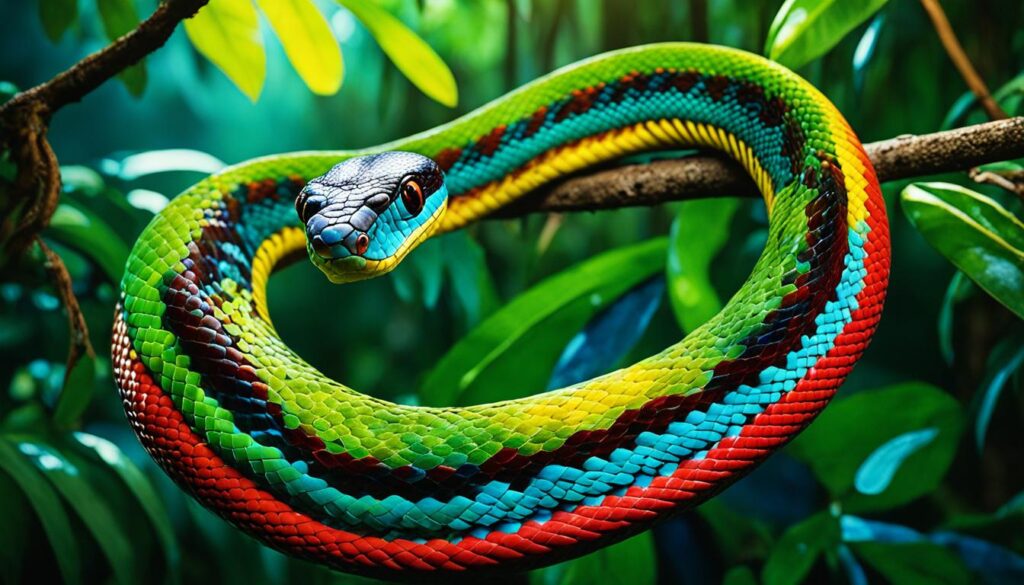
Feline Predators: Jaguars and Ocelots
In the tropical rainforest, many feline hunters live. They all have special ways to catch food and like different kinds of prey. The jaguars stand out as some of the biggest and most amazing. The ocelots, smaller but fast, are also very impressive.
Jaguars are the biggest cats in the Americas. They have strong jaws and sharp claws. This lets them hunt a variety of animals, from deer to large birds like macaws. Jaguars usually surprise their prey. They hide and then attack with great speed.
Ocelots are smaller but just as skilled. They focus on catching little birds in the rainforest’s lower parts. Ocelots blend in well with their surroundings and have sharp reflexes. This helps them catch birds by surprise.
These big and small cats show how complex the rainforest’s ecosystem is. Jaguars and ocelots, as the top predators, are vital for the rainforest. They help keep other animal numbers in check, which keeps the environment balanced and healthy.
“The jaguar is the largest cat in the Americas and a symbol of the untamed power of the rainforest.”
The jaguar and the ocelot are truly fascinating creatures of the rainforest. They symbolize its wild and powerful nature. These cats show us the beauty and strength of this ancient place.
Primates: Unexpected Hunters
While many think of primates eating mostly plants or anything, some thrive on hunting in the rainforests. Specific monkey types, for example, have been seen catching small birds in the trees. This behavior of going after birds is quite a surprise to many.
Monkeys as Opportunistic Predators
The clever brown capuchin monkey is famous for its bird-chasing skills. It can nab parakeets, showing how versatile primates in the rainforest can be. They use their wits to find food in a tough, crowded place like the jungle.
Different kinds of primates, including monkey species, use various tricks to hunt birds. Some sneak up slowly, jumping out at just the right moment. Others go straight for nests, stealing eggs or young birds. This proves they’re smart and make the most of what’s around them.
“Primates are often thought of as primarily herbivorous or omnivorous, but the reality is that some species have developed sophisticated hunting behaviors to supplement their diets with protein-rich sources like birds.”
This hunting by primates in the rainforest is truly eye-opening. It shows how everything is linked in the food chain. Even those that usually don’t eat meat can fill that role, depending on what’s available.
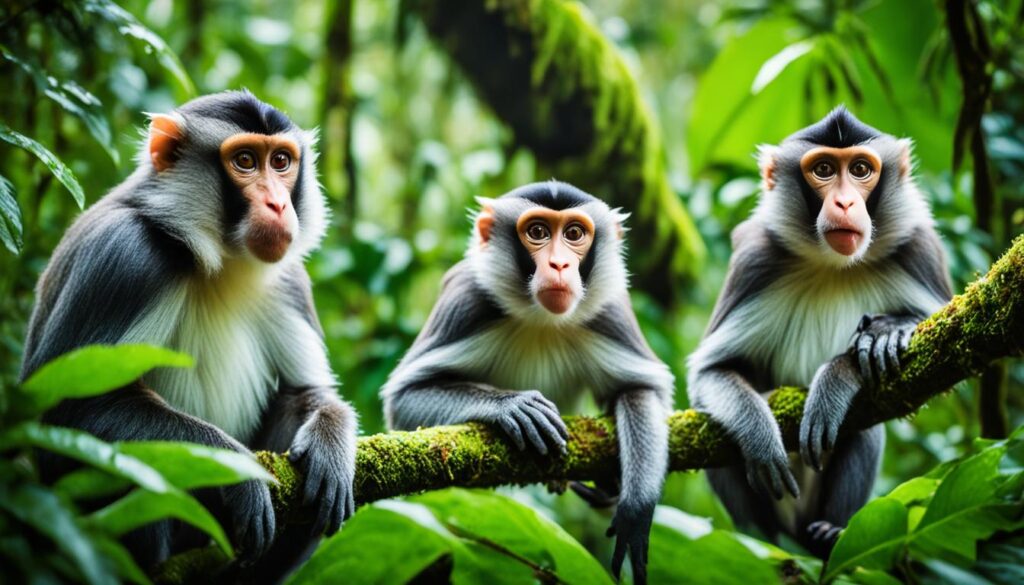
Learning about how rainforest primates eat gives us a new respect for them. They are clearly very smart and able to handle the tough challenges of their forest homes.
Bats: Nighttime Terrors
When we imagine the foes of the rainforest, bats don’t usually come first. But, these night flyers are key players in the rainforest’s life web. They pose dangers to birds too. The False Vampire Bat, the biggest in the New World, is a top example of this. It preys on birds, showing how diverse and challenging life in the rainforest is.
Imagine a bat with wings spreading up to three feet. This is the False Vampire Bat. At night, it surprises sleeping birds, taking them back to its home. It’s a clear sign of the dangers that lurk in the dark for birds, thanks to these bats.
“The False Vampire Bat is a true apex predator in the rainforest, striking fear into the hearts of even the most vigilant bird species.”
Most rainforest bats eat insects. But the False Vampire Bat stands out by hunting birds. This shows how fragile the balance of the rainforest is. As these bat predators grow in number, birds must stay sharp to survive against these nighttime terrors.
From small songbirds to grand raptors, bats in the rainforest remind us of nature’s complexity. It’s a place where survival is a continuous battle between hunters and the hunted.
Bird Survival Tactics
In the lively but dangerous tropical rainforest, birds use smart strategies to keep safe. They protect themselves and their young from many predators. They do this by working together in flocks and placing their nests in smart spots. These strategies help them live in the wild.
Flock Behavior and Vigilance
Birds often gather in big groups to stay safe. This way, they have more eyes watching for danger. If a threat appears, they can alert each other quickly. This flock behavior keeps them on alert all the time.
- Improved predator detection through collective surveillance
- Increased coordination and alarm call response within the flock
- Safer foraging and movement through the dense rainforest canopy
Nest Selection and Parental Vigilance
Choosing where to build a nest is very important for bird parents. They like high, open places where they can see everything. This way, they spot any danger early and protect their young better.
After the baby birds hatch, parents are super careful. They stay quiet and watchful. If danger comes close, they warn their babies. The parents fight hard to keep their little ones safe from harm.
| Survival Tactic | Description | Benefit |
|---|---|---|
| Flock Behavior | Birds unite in big groups to watch out for each other and detect predators. | This increases their safety, cooperation, and food gathering. |
| Nest Selection | Birds pick high, open nests for a better view and to defend against enemies. | It helps them keep the nest safe from predators by having a clear view. |
| Parental Vigilance | Parents are very alert around their nest, doing whatever it takes to protect their young. | This raises the chances of their baby birds growing up safely. |
By using these smart tactics, the birds of the rainforest don’t just survive. They thrive, keeping their species strong and the ecosystem in balance.
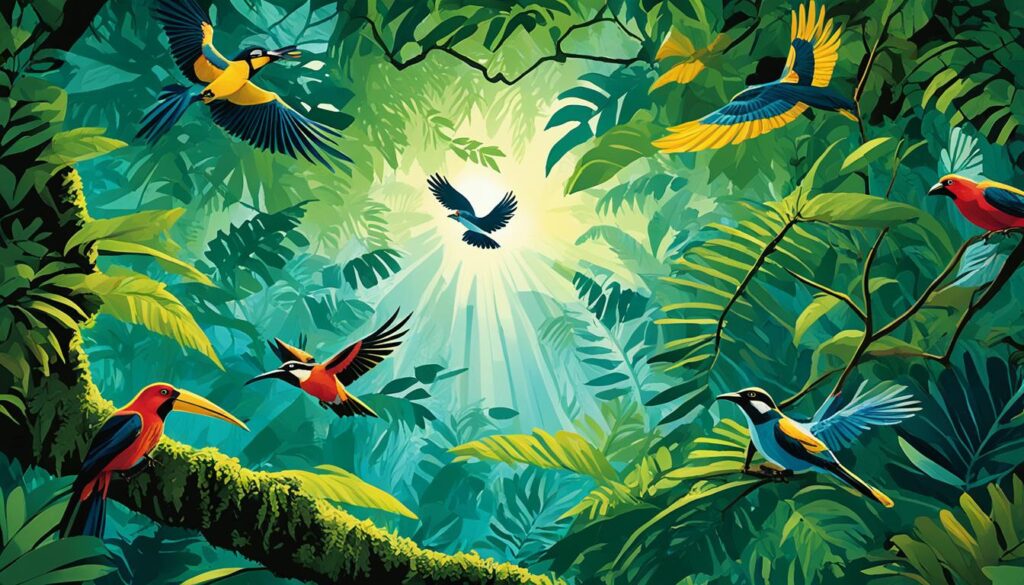
“The rainforest is a symphony of life, where birds play a vital role in the intricate dance of survival.”
Conclusion
The rainforest is more than just trees. It’s a playground of life and death, where birds face many perils. They dodge raptors, snakes, and jungle cats. Even bats join the hunt. Despite these dangers, birds find ways to live. They stick together, keep watch, and pick safe spots to build nests. This helps them not only survive but also stand strong in a tough world.
Protecting the rainforest means understanding its secrets. By learning how birds and their foes interact, we learn to defend all life here. Saving the rainforest is key to keeping our planet alive and well. Birds, with their fight for existence, represent the hope not just for their kind, but for all of the Amazon’s wonders.
The rainforest is a grand show of nature’s magic, where life and death dance finely. By caring and learning about it, we keep this miracle alive. This way, children of the future can continue to explore this rich, endless world.
FAQ
What are the main predators that eat birds in the tropical rainforest?
Raptors like hawks, eagles, and owls, along with snakes and big cats like jaguars and ocelots, are the main bird eaters in the tropical rainforest. Primates and bats also catch birds for their meals.
How do birds in the rainforest survive and protect themselves from these predators?
Birds in the rainforest use smart ways to keep safe. They stay in groups and pick safe spots to build their nests. When predator danger nears, they watch closely and make loud signals to warn others. They move quietly to stay hidden.
What is the role of insects in the tropical rainforest ecosystem?
Insects are super important in the rainforest. They eat and break down dead stuff, help the soil breathe, and feed bigger animals. Some special insects in the rainforest are way bigger than normal, because it’s always warm.
What makes the poison dart frogs of the tropical rainforest so unique?
Poison dart frogs are known for their pretty colors and harmful skin. They use their poison to keep safe from enemies. People living in the rainforest use this poison for hunting too.
How do reptiles, such as snakes and lizards, thrive in the tropical rainforest environment?
Reptiles are perfect for the rainforest. They hide well and use special ways to catch food. Big snakes, like anacondas, squeeze their food. Snakes like the coral snake have poison to fight with.
What is the role of the piranha in the tropical rainforest’s aquatic ecosystem?
Piranhas, the famous sharp-toothed fish, live in the Amazon River. They eat plants and give back nutrients through their waste. This makes the soil rich and helps everything around them grow.
How do mammals, from small rodents to large predators, contribute to the balance of the tropical rainforest ecosystem?
All the mammals in the rainforest help in big ways. From tiny mice to huge jaguars, they are part of a big food chain. Some animals eat others, helping keep the balance. But we, humans, must take care to not disturb this balance.
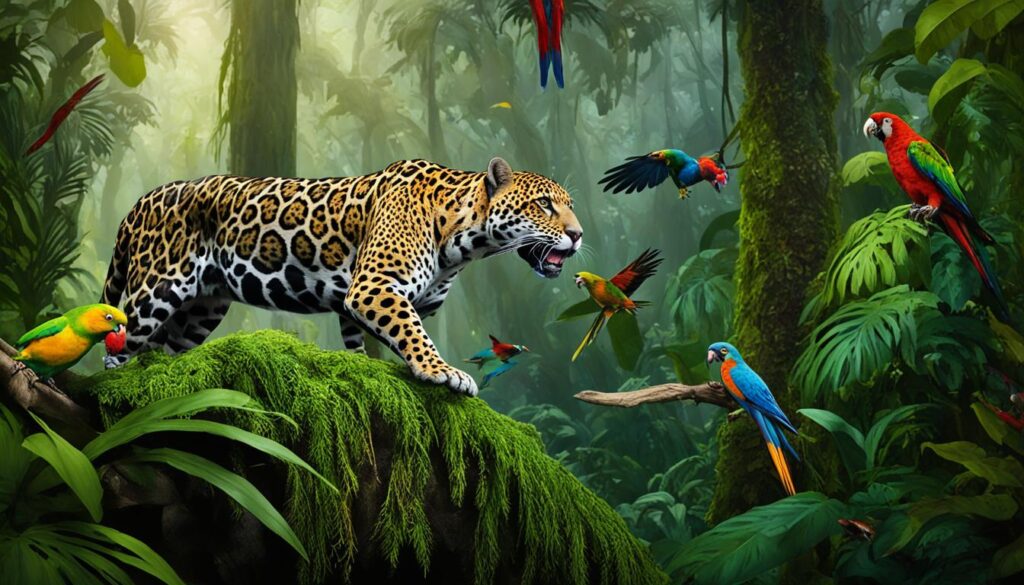

I was recommended this blog by my cousin. I’m not sure
whether this post is written by him as no one else know such detailed
about my problem. You are amazing! Thanks!
Your ideas absolutely shows this site could easily be one of the bests in its niche. Drop by my website Webemail24 for some fresh takes about Blogging. Also, I look forward to your new updates.
Impressive posts! My blog Seoranko about Card Games also has a lot of exclusive content I created myself, I am sure you won’t leave empty-handed if you drop by my page.